Basic Structure of the Constitution | Indian Polity for UPSC CSE PDF Download
| Table of contents |

|
| Basic Structure Doctrine |

|
| Judgement: Some Basic Structures of the Constitution |

|
| Basic Structure Doctrine - Elements |

|
| Evolution of the Basic Structure Doctrine |

|
Basic Structure Doctrine
Basic Structure Doctrine was propounded by Justice Hans Raj Khanna, in Kesavananda Bharti Case (1973) that the Constitution of India has certain basic features that can’t be altered or destroyed through amendments by the parliament.
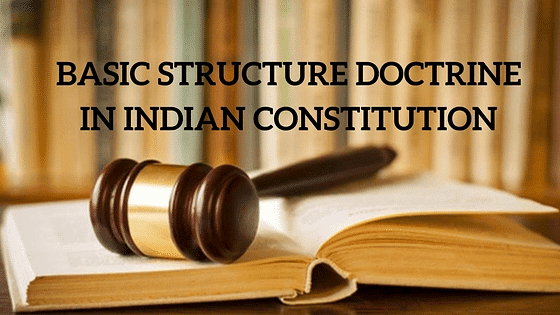
- Though basic structure is not defined anywhere in the constitution, it reflects through some of its constituents (as many times defined and narrated by the judiciary), i.e. Republic nature of India, sovereignty, Rule of Law, republic nature of Indian polity, liberty, judicial review, secularism, Separation of power, etc.
- The primary purpose of this doctrine is to preserve the sole idea and philosophy of the original constitution.
- This doctrine only applies to constitutional amendments, mainly those amendments that can destroy or change basic philosophical ideas of the original constitution. Any law that violates basic structure doctrine is declared null by the Supreme Court.
- It was the Kesavananda Bharati case that brought this doctrine into the limelight. It held that the “basic structure of the Constitution could not be abrogated even by a constitutional amendment”.
Judgement: Some Basic Structures of the Constitution
Kesavananda Bharati Case Judgement listed some basic structures of the Constitution as:
- Supremacy of the Constitution
- Unity and Sovereignty of India
- The democratic and republican form of government
- Federal character of the Constitution
- Secular Character of the Constitution
- Separation of power
- Individual freedom
Over time, many other features have also been added to this list of basic structural features. Some of them are:
- Rule of law
- Judicial review
- Parliamentary system
- Rule of equality
- Harmony and balance between the Fundamental Rights and DPSP
- Free and fair elections
- Limited power of the parliament to amend the Constitution
- Power of the Supreme Court under Articles 32, 136, 142 and 147
- Power of the High Court under Articles 226 and 227
Any law or amendment that violates these principles can be struck down by the SC because they distort the basic structure of the Constitution.
Basic Structure Doctrine - Elements
The Supreme Court has yet to define or clarify what constitutes the basic structure of the Constitution. From the various judgments, the following have emerged as basic features of the Constitution or elements of the basic structure of the Constitution:
- Supremacy of the Constitution.
- Sovereign, democratic and republican nature of the Indian polity.
- Secular character of the Constitution.
- Separation of powers between the legislature, the executive, and the judiciary.
- Federal character of the Constitution.
- Unity and integrity of the nation.
- Welfare state (socio-economic justice).
- Judicial review.
- Freedom and dignity of the individual.
- Parliamentary system.
- Rule of law.
- Harmony and balance between Fundamental Rights and Directive Principles.
- Principle of equality.
- Free and fair elections.
- Independence of Judiciary.
- Limited power of Parliament to amend the Constitution.
- Effective access to justice 18. Principles (or essence) underlying fundamental rights.
- Powers of the Supreme Court under Articles 32, 136, 141 and 142.
- Powers of the High Courts under Articles 226 and 227.
Evolution of the Basic Structure Doctrine
This doctrine evolved through so many cases, i.e. through many judicial and legal interpretations:
Shankari Prasad Case (1951)
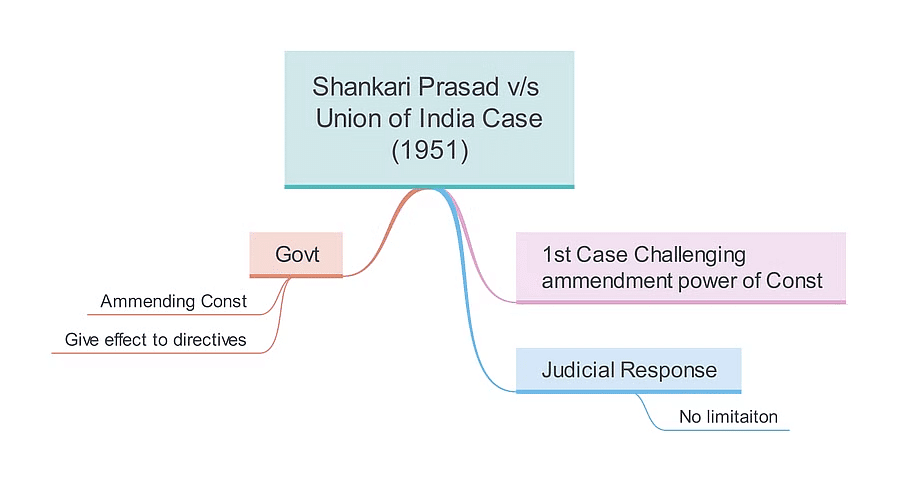
- In this case, the SC contended that the Parliament’s power of amending the Constitution under Article 368 included the power to amend the Fundamental Rights guaranteed in Part III as well.
Sajjan Singh case (1965)
- In this case, the SC also held that the Parliament can amend any part of the Constitution including the Fundamental Rights.
- It is noteworthy to point out that two dissenting judges, in this case, remarked on whether the fundamental rights of citizens could become a plaything of the majority party in Parliament.
Golaknath case (1967)
- In this legal case, the court changed its previous decision on altering fundamental rights in the constitution.
- The court now asserts that changing fundamental rights isn't straightforward for the government.
- Article 13 protects fundamental rights, making them immune to regular parliamentary changes.
- To modify these rights, a special group called a Constituent Assembly is required.
- Article 368 provides a way to amend the Constitution but doesn't grant unlimited power to Parliament.
- The court highlights the unique and crucial place of fundamental rights in the Constitution.
- The majority opinion suggests unspoken limits on the government's ability to change the Constitution.
- Judges argue that certain rights were intentionally made difficult to change, signifying their special and lasting status.
Kesavananda Bharati case (1973)

- The case marked a turning point in establishing the basic structure doctrine.
- The Supreme Court ruled that while the Parliament could amend any part of the Constitution, including Fundamental Rights, it couldn't abolish the "basic structure of the Constitution" through amendments.
- Essentially, the judgment conveyed that the Parliament can make changes to the Constitution, but it cannot completely rewrite it. The power to amend doesn't mean the power to destroy.
- In Indian law, this principle allows the judiciary to reject any amendment passed by Parliament if it contradicts the fundamental framework or core principles of the Constitution, known as the basic structure.
Indira Nehru Gandhi v. Raj Narain case (1975)
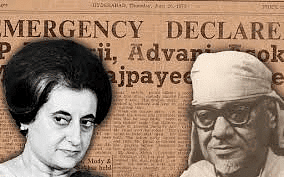
- In this case, the Supreme Court applied the basic structure theory and invalidated Clause (4) of Article 329-A, introduced by the 39th Amendment in 1975.
- The 39th Amendment Act, enacted during the Emergency Period, aimed to shield the elections of the President, Vice President, Prime Minister, and Speaker of the Lok Sabha from judicial review.
- The Court ruled that Clause (4) of Article 329-A went beyond the Parliament's amending power as it undermined the fundamental features of the Constitution.
- The background of this amendment was linked to the government's attempt to protect Indira Gandhi from prosecution by the Allahabad High Court for alleged corrupt electoral practices.
Minerva Mills Case (1980)
- This case further reinforced the Basic Structure doctrine by nullifying two modifications introduced by the 42nd Amendment Act of 1976, deeming them in violation of the basic structure.
- The judgment emphasized that the Constitution, not the Parliament, holds supreme authority.
- The Court, in this instance, included two elements in the fundamental structure: judicial review and maintaining a balance between Fundamental Rights and Directive Principles of State Policy (DPSP).
- The judges asserted that the Constitution's fundamental nature includes a restricted amending power, making it a basic feature.
Waman Rao Case (1981)
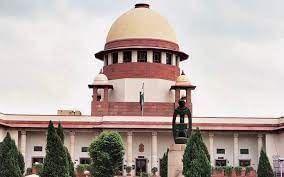
- The Supreme Court once again affirmed the Basic Structure doctrine.
- It established a clear distinction from April 24th, 1973, the date of the Kesavananda Bharati judgment, stating that the doctrine should not be applied retroactively to question the validity of amendments made before that date.
- In the Kesavananda Bharati case, the petitioner contested the Constitution (29th Amendment) Act, 1972, which included the Kerala Land Reforms Act, 1963, and its amending Act in the 9th Schedule of the Constitution.
- The 9th Schedule, added by the First Amendment in 1951 with Article 31-B, aimed to shield land reform laws from legal challenges.
- Article 13(2) prohibits laws inconsistent with fundamental rights, but Article 31-B and the 9th Schedule protect certain laws, making them immune to court challenges.
- The Waman Rao case determined that amendments made to the 9th Schedule until the Kesavananda judgment are valid, but those made after that date can be scrutinized for conformity with the Constitution.
Indra Sawhney and Union of India (1992)
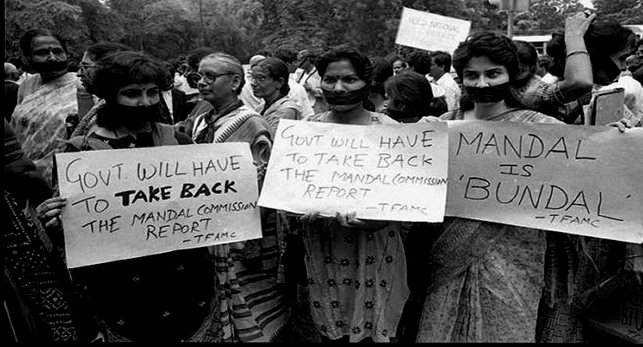
- SC examined the scope and extent of Article 16(4), which provides for the reservation of jobs in favour of backward classes. It upheld the constitutional validity of 27% reservation for the OBCs with certain conditions (like creamy layer exclusion, no reservation in promotion, total reserved quota should not exceed 50%, etc.)
- Here, ‘Rule of Law’ was added to the list of basic features of the constitution.
S.R. Bommai case (1994)
- In this case, the Supreme Court aimed to prevent the improper use of Article 356, which deals with the imposition of the President's Rule on states.
- While there was no issue related to constitutional amendments, the court applied the concept of the basic structure doctrine.
- The judgment established that if the policies of a state government were contrary to a fundamental aspect of the Constitution's basic structure, it could be considered a legitimate reason for the central government to use its power under Article 356 to impose the President's Rule in that state.
|
150 videos|780 docs|202 tests
|
FAQs on Basic Structure of the Constitution - Indian Polity for UPSC CSE
| 1. What is the Basic Structure Doctrine? |  |
| 2. What are the elements of the Basic Structure Doctrine? |  |
| 3. How has the Basic Structure Doctrine evolved over time? |  |
| 4. What is the significance of the Basic Structure Doctrine in the Indian Constitution? |  |
| 5. What are some examples of cases where the Basic Structure Doctrine has been applied? |  |
















